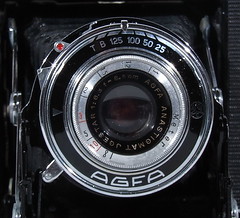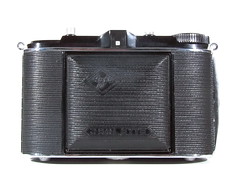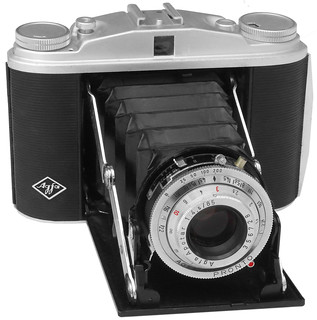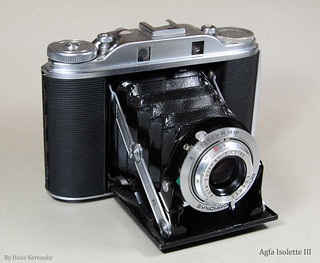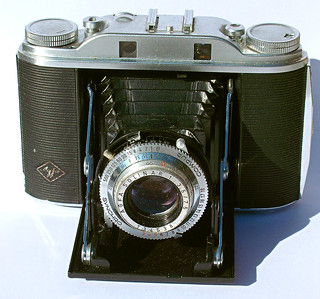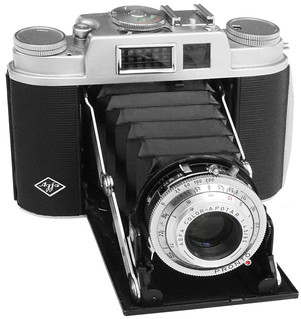Difference between revisions of "Isolette"
m (Commented out the model list; this article only covers the late 1930s camera.) |
m (→Isolette III: just added type (part# as seen in a box)) |
||
| (98 intermediate revisions by 13 users not shown) | |||
| Line 1: | Line 1: | ||
| − | |||
| − | |||
| − | + | The '''Isolette''' is the name of a series of compact horizontal-[[folding]] camera for twelve 6×6 cm (2¼-inch square) pictures or sixteen 4.5×6 cm (2¼×1⅝ inch) pictures, (only on the first model of the camera) on [[120 film]]. It was made by [[Agfa]] Kamerawerk AG, Munich, Germany, starting in 1937,<ref name=McK>{{McKeown12}} p25.</ref> and resuming after the war (1947-48); the series of cameras continued until about 1960. | |
| − | + | {{RightTOC}} | |
| − | + | Some of the series were sold (and some ''made'') in North America by [[Ansco]] as [[Speedex]] models. | |
| − | + | {| | |
| − | + | |The cameras are as follows: | |
| − | * | + | * The original Isolette (1937-42) |
| − | * | + | * Isolette 4.5 (1945-50) |
| − | * | + | * Isolette V (1950-52) - ''Ansco Speedex 4.5'' |
| − | * | + | * Isolette I (1951-58) |
| − | * | + | * Isolette II (1950-60) - ''Ansco Speedex 4.5 Special'' |
| − | + | * Isolette III (1952-58) - ''Ansco Speedex Special R'' | |
| − | * | + | * Isolette L (1957-60) |
| − | -- | + | | |
| + | |{{Flickr_image | ||
| + | |image_source= https://www.flickr.com/photos/s-demir/5351077121/in/pool-camerawiki | ||
| + | |image= http://farm6.staticflickr.com/5090/5351077121_90074962c5_n.jpg | ||
| + | |image_align= | ||
| + | |image_text= Isorette | ||
| + | |image_by= Süleyman Demir | ||
| + | |image_rights= wp | ||
| + | }} | ||
| + | |} | ||
| + | There was also the [[Super Isolette]] (1954-60), a coupled-rangefinder camera. | ||
| − | == | + | ==Isolette== |
| + | {|class=floatright | ||
| + | |{{Flickr_image | ||
| + | |image_source= https://www.flickr.com/photos/greyscale3/11004807734/in/pool-camerawiki/ | ||
| + | |image=https://live.staticflickr.com/3710/11004807734_34c1c11e2c_n.jpg | ||
| + | |image_align= right | ||
| + | |image_text= Isorette, with Solinar and Compur-Rapid shutter | ||
| + | |image_by= Mike Novak | ||
| + | |image_rights= with permission | ||
| + | }} | ||
| + | |- | ||
| + | | | ||
{{Flickr_image | {{Flickr_image | ||
| − | |image_source= | + | |image_source=https://www.flickr.com/photos/raulm/3984687578/in/pool-camerawiki |
| − | |image= | + | |image=https://live.staticflickr.com/3470/3984687578_bc7446c4e7_n.jpg |
|image_align= right | |image_align= right | ||
| − | |image_text= | + | |image_text= Isolette, with Agnar and Compur shutter |
|image_by= Raúl Sá Dantas | |image_by= Raúl Sá Dantas | ||
|image_rights= with permission | |image_rights= with permission | ||
}} | }} | ||
| + | |} | ||
| + | This first model (1937-42) is a dual format camera. It has hinged masks in the film chamber (they pivot around the spindle of the film rollers on each side of the film gate), to change it from the 6×6 cm (2¼ inch square) format to 4.5×6 cm (2¼×1⅝ inch). There is also a mask for the viewfinder, put in place with a selector lever by the eyepiece. | ||
| + | |||
| + | It first came on the market as the '''Iso''r''ette''' (embossed in the leatherette of the front door/lens bed as <small>'''J'''SORETTE</small><ref>The name is written as Jsolette simply because the capital "I" resembles a "J" in German typography of the time. The embossing on the camera was changed to a modern "I" in 1937. See: [https://web.archive.org/web/20120120070614/http://www.kindredroots.com/What/germanletters/germanletters_caps.htm Old German Letters] (archived)</ref> ), but the name was changed to '''Isolette''' (again, marked on the camera as <small>'''J'''SOLETTE</small>) within a year, with no significant change to the camera itself. | ||
| − | + | One of the distinctive features of the camera is the top housing, made of a plastic called 'Trolitan';<ref>In fact, Trolitan Presswerk made products in many types of thermoplastic and thermoset resins (and still does; see the [http://www.trolitan.fr/index.php company website], retrieved July 2020). The company held patents for several moulded polymer products in the 1950s and 60s: see [https://worldwide.espacenet.com/patent/search?q=ia%20%3D%20%22Trolitan%22 a list] at [http://worldwide.espacenet.com/ Espacenet]. The Isolette top housing is of a bakelite-like material.</ref> the post-War camera has a cast aluminium top housing. The Trolitan-topped camera also has metal loops to attach a strap, the only version of the Isolette to have these. | |
| − | This model was called | + | Different lens and shutter combinations were available, allowing a wide range of levels of specification. All have front-element focusing. The shutter release is on the body. Film advance is by a wide, flat knob, using a [[red window]]; there are ''two'' red windows in the back, one for each film format, and a swivelling cover for the upper (4.5×6 cm) one. |
| + | There is a swing-out spool holder on the supply side of the film chamber. This model was called the "Soldatenkamera" (soldier's camera) in Germany during the War. | ||
| − | + | * Year of release: 1937<ref name=McK/> | |
| + | * Film Format: 12 exp. 6x6 or 16 exp. 4.5x6 on [[120 film|120 type rollfilm]]. | ||
| + | * Shutter: [[Vario]], [[Pronto]], [[Prontor|Prontor II]], [[Compur]] or [[Compur-Rapid]]. | ||
| + | * Lens: 8.5 cm f/6.3 Igestar, f/4.5 Agnar, f/4.5 Apotar or f/4.5 Solinar. | ||
| + | * Viewfinder: reverse-Galilean viewfinder | ||
| − | + | The earliest cameras have Vario shutters which are not labelled and only have the AGFA markings. | |
| − | |||
| − | |||
| − | |||
| − | |||
| − | |||
| − | |||
| − | |||
| − | |||
| − | |||
{|class=plainlinks align="center" | {|class=plainlinks align="center" | ||
| − | + | | | |
{{Flickr_image | {{Flickr_image | ||
| − | |image_source= http://www.flickr.com/photos/s-demir/ | + | |image_source= http://www.flickr.com/photos/s-demir/5351689218/in/pool-camerawiki/ |
| − | |image= http://farm6.static.flickr.com/ | + | |image= http://farm6.static.flickr.com/5206/5351689218_2c26a5db61_m.jpg |
|image_align= | |image_align= | ||
|image_text= | |image_text= | ||
| Line 55: | Line 74: | ||
|image_rights= | |image_rights= | ||
}} | }} | ||
| − | + | | | |
{{Flickr_image | {{Flickr_image | ||
|image_source= http://www.flickr.com/photos/s-demir/5351079367/in/pool-camerawiki/ | |image_source= http://www.flickr.com/photos/s-demir/5351079367/in/pool-camerawiki/ | ||
| − | |image= http://farm6.static.flickr.com/5284/5351079367_3a19f86223_m.jpg | + | |image= http://farm6.static.flickr.com/5284/5351079367_3a19f86223_m.jpg |
| − | + | |image_align= | |
| − | |||
| − | |||
| − | |||
| − | |||
| − | |||
| − | |||
| − | |||
| − | |||
| − | |image_align= | ||
|image_text= | |image_text= | ||
|image_by= | |image_by= | ||
| − | |image_rights= | + | |image_rights= |
}} | }} | ||
|- | |- | ||
| − | |colspan= | + | |colspan=2 align="center"| Isolette, first model, about 1937, with Igestar anastigmat and Pronto shutter. |
| − | <small>Images by Süleyman Demir | + | <small>Images by [[:Category:Image by Süleyman Demir|Süleyman Demir]]</small> {{with permission}} |
|} | |} | ||
| − | == | + | ==Isolette 4.5== |
| + | |||
| + | {|class=floatright | ||
| + | | | ||
{{Flickr_image | {{Flickr_image | ||
| − | |image_source= | + | |image_source=https://www.flickr.com/photos/29504544@N08/5274371955/in/pool-camerawiki |
| − | |image= | + | |image=https://live.staticflickr.com/5002/5274371955_2ba455deb5_n.jpg |
|image_align= right | |image_align= right | ||
| − | |image_text= | + | |image_text= Post-War Isolette |
|image_by=Hans Kerensky | |image_by=Hans Kerensky | ||
|image_rights= with permission | |image_rights= with permission | ||
| − | }} | + | }} |
| − | The | + | |- |
| + | |{{Flickr_image | ||
| + | |image_source= https://www.flickr.com/photos/64947908@N05/9465857074/in/pool-camerawiki | ||
| + | |image=https://live.staticflickr.com/5523/9465857074_6af4474f8c_n.jpg | ||
| + | |image_align= right | ||
| + | |image_text= Isolette 4.5 with Solinar | ||
| + | |image_by= OZBOX | ||
| + | |image_rights= wp | ||
| + | }} | ||
| + | |} | ||
| + | The first post-War model was made from 1945 till 1950. It is not adjustable to 4.5×6 cm format. The top housing of this model is cast from Hydronalium (Nüral: an aluminium alloy). Early models still keep the Jsolette embossing on the front. There were less lens and shutter combinations, offering only the higher levels of specification (no Agnar, nor Vario or Pronto shutters). Most of the lenses are still uncoated.<ref name=McK/> Some of the shutters available are synchronised. The camera offered an accessory shoe (above the viewfinder) in later models. Like most of the post-War Isolettes, the camera takes 30 mm push-on hood and filters. | ||
* Year of release: 1945 | * Year of release: 1945 | ||
| − | * Film Format: 12 exp. 6x6 on [[120 film | + | * Film Format: 12 exp. 6x6 on [[120 film]]. |
* Shutter: [[Prontor]], Prontor-S or [[Compur-Rapid]]. | * Shutter: [[Prontor]], Prontor-S or [[Compur-Rapid]]. | ||
| − | * Lens: Apotar 4.5 | + | * Lens: Apotar 8.5cm f/4.5 or Solinar 8.5cm f/4.5. |
* Double exposure prevention. | * Double exposure prevention. | ||
| − | * Viewfinder: | + | * Viewfinder: reverse-Galilean viewfinder |
| + | |||
| + | {{br}} | ||
| + | |||
| + | ==Isolette V== | ||
| + | {|class="floatright plainlinks" | ||
| + | | | ||
| + | {{Flickr_image | ||
| + | |image_source= http://www.flickr.com/photos/raulm/3061172185/in/pool-camerawiki | ||
| + | |image= http://farm4.static.flickr.com/3272/3061172185_05c7ecaa27_n.jpg | ||
| + | |image_align= | ||
| + | |image_text= Isolette V, with f/4.5 Agnar and Vario shutter.<br> The upright metal strip at the side of the shutter is the release.<br> Note the control added to offer 'T' as well as 'B' shutter. | ||
| + | |image_by= Raúl Sá Dantas | ||
| + | |image_rights= with permission | ||
| + | }} | ||
| + | |} | ||
| + | |||
| + | The '''Isolette V''', made from 1950 to '52, has Agfa's entry-level f/4.5 Agnar triplet lens, and only low-specification shutters (Pronto or Vario).<ref name=UrmonasV>[http://www.urmonas.net/manuals/isoletteV.pdf User's manual for the Isolette V] at [http://www.urmonas.net/index.html Richard Urmonas' homepage]. The last page is a correction slip regarding the specifications of the two shutters, and the position of the accessory shoe, which had moved since the manual was produced. Interestingly, the slip gives the company as Agfa Camera Werk, München, ''US Administration''; the Bundesrepublik (West Germany) had only just been formed.</ref> However, the lens is now coated on many examples, and the shutters are synchronised, with a [[PC socket]]. The camera's top housing is now of pressed, bright silver metal: this finish is retained for the rest of the series. The accessory shoe is either on top of the viewfinder or to one side of it (on earlier examples).<ref name=UrmonasV/> There is no body-mounted shutter release. The embossing on the front of the camera has a V clearly visible under the Isolette denomination. Sold also as ANSCO [[Speedex]] 4.5 in the USA | ||
| + | {{br}} | ||
| + | |||
| + | ==Isolette I== | ||
| + | {|class="floatright" | ||
| + | | | ||
| + | {{Flickr_image | ||
| + | |image_source= https://www.flickr.com/photos/alf_sigaro/1799585165/in/pool-camerawiki | ||
| + | |image= https://live.staticflickr.com/2362/1799585165_0db043f290_n.jpg | ||
| + | |image_align= | ||
| + | |image_text= Isolette I; second version with DOF scale on the shutter face-plate. | ||
| + | |image_by= Alf Sigaro | ||
| + | |image_rights= non-commercial | ||
| + | }} | ||
| + | |} | ||
| + | The '''Isolette I''' (1951-58) is, like the V, a rather low-specification model. It has a coated f/4.5 Agnar lens, and a synchronised Vario or Pronto shutter. Unlike the V, it has a body shutter release. There are two versions of it: | ||
| + | * 1951-54: the early version has a disc-shaped depth-of-field calculator, mounted in a position matching that of the film advance knob, but on the right of the camera. | ||
| + | * 1955-58: the depth-of-field calculator is now absent; some (but not all) examples have DOF brackets marked on the face-plate of the shutter, around the focus scale of the lens. This model also has a slightly different [[cold shoe]]. | ||
| + | {{br}} | ||
| + | |||
| + | ==Isolette II== | ||
| + | {|class="floatright plainlinks" | ||
| + | | | ||
| + | {{Flickr_image | ||
| + | |image_source= http://www.flickr.com/photos/alf_sigaro/1950337580/in/pool-camerawiki/ | ||
| + | |image=https://live.staticflickr.com/2367/1950337580_c0bd9060b1_n.jpg | ||
| + | |image_align= center | ||
| + | |image_text= Agfa Isolette II, showing the characteristic wide raised<br/>centre of its top housing. The thick knurled disc on<br />the right (of the picture) is a film-type reminder dial. | ||
| + | |image_by= Alf Sigaro | ||
| + | |image_rights= non-commercial | ||
| + | }} | ||
| + | |} | ||
| + | The '''Isolette II''' (1950-60) was sold alongside the 'I'; it is an alternative model offering higher specification than the 'I', not a successor to it. Top plate is different to the 'I' with a more rounded look. The camera was available (for at least some time) with coated 85 mm f/4.5 Agnar or Apotar or 75 mm f/3.5 Solinar lenses;<ref name=UrmonasII>[http://www.urmonas.net/manuals/isoletteII.pdf User's manual for the Isolette II] at [http://www.urmonas.net/index.html Richard Urmonas' homepage].</ref> however, most examples seen have the Apotar. McKeown gives a very wide range of shutters (Vario, Pronto, Prontor-S and SV, Compur Rapid and Synchro-Compur). This reflects changes in the specification and availability of shutters over the period the camera was made (i.e. not all of these shutters were available at the same time): for example, a user's manual (of unknown date) only lists the Pronto and Prontor SVS.<ref name=UrmonasII/> Also some Vario and Pronto shutters were only marked AGFA (white letters on black background). | ||
| + | The range of shutter speeds is therefore variable between examples. Some of the shutters have a delayed action. Most are synchronised (some have switchable M and X-synchronisation). On ''some'' examples of the camera, there is a shutter locking lever on the back of the top housing, to provide 'T' shutter by locking the release button down, where the shutter itself does not have a 'T' setting. | ||
| + | |||
| + | It was sold in the USA as [[Ansco Speedex]] 4.5 Special | ||
| + | |||
| + | |||
| + | {{Flickr_image | ||
| + | |image_source= https://www.flickr.com/photos/40524247@N00/8858952975/in/pool-camerawiki | ||
| + | |image= http://farm4.staticflickr.com/3744/8858952975_ca401e0e53_q_d.jpg | ||
| + | |image_align= left | ||
| + | |image_text= fast [[Solinar]] lens | ||
| + | |image_by= Fernando Soares | ||
| + | |image_rights= wp | ||
| + | }} Unlike the Isolette I and all the preceding models, the film advance knob is on the right. The camera still has a swing-out spool-holder on the supply side of the film chamber. | ||
| + | |||
| + | Under the modified top, there is a double-exposure prevention interlock; this engages after releasing the shutter, and is disengaged by advancing the film. It has a red (locked) or silver (unlocked) indicator in a hole in the top-plate, next to the advance knob. Like the 'T' lock, this interlock acts on the body release button, so if the lock engages accidentally, or a double exposure is desired, it is still possible to release the shutter by pressing the linkage on the shutter itself (or with a cable release, on versions of the camera on which the cable attaches directly to the shutter, not the body release; they vary in this respect). | ||
| + | |||
| + | Like the Isolette I, early versions of the II have a disc-type depth-of-field indicator on the left of the top plate.<ref name=R&C1>[http://www.rolandandcaroline.co.uk/isoletteii/dof.html Depth of field indicator] on an Isolette II, at [http://www.rolandandcaroline.co.uk/index.html Roland and Caroline].</ref> On later cameras this is replaced with a film-type reminder, and the DOF scale, if any, is on the shutter face-plate. | ||
| + | |||
| + | {| class="floatleft plainlinks" style="text-align: center" | ||
| + | |[http://www.flickr.com/photos/50678983@N00/179261315/in/pool-camerawiki http://static.flickr.com/77/179261315_5e334d571a_m.jpg] | ||
| + | |[http://www.flickr.com/photos/50678983@N00/179261313/in/pool-camerawiki http://static.flickr.com/51/179261313_1a9a1abeca_m.jpg] | ||
| + | |[http://www.flickr.com/photos/50678983@N00/179261317/in/pool-camerawiki http://farm1.static.flickr.com/45/179261317_582f185745_m_d.jpg]<br/> | ||
| + | |- | ||
| + | |Isolette II with Compur-Rapid<br/>shutter (1 - 1/500 second plus 'B') | ||
| + | |Top plate, showing disc-type DOF scale<br/>and double-exposure indicator. | ||
| + | |The lever to the right of the viewfinder<br/>switches 'B' shutter to 'T'. | ||
| + | |- | ||
| + | | colspan=3 |<small> Images by {{image author|Dries van den Elzen}}</small> {{with permission}} | ||
| + | |- | ||
| + | |[http://www.flickr.com/photos/heritagefutures/5463993216/in/pool-camerawiki http://farm6.static.flickr.com/5013/5463993216_1f084fa1c8_m.jpg] | ||
| + | |- | ||
| + | |The Isolette II was sold as Ansco's<br/>[[Speedex]] 4.5 Special in the USA. | ||
| + | |- | ||
| + | |<small>Image by {{image author|Dirk HR Spennemann}}</small> {{with permission}} | ||
| + | |} | ||
| + | <br style="clear:both;" /> | ||
| + | |||
| + | |||
| + | {{br}} | ||
| + | |||
| + | ==Isolette III== | ||
| + | {|class="floatright" | ||
| + | | | ||
| + | {{Flickr_image | ||
| + | |image_source= http://www.flickr.com/photos/29504544@N08/5234124233/in/pool-camerawiki/ | ||
| + | |image= http://farm6.static.flickr.com/5004/5234124233_acac55f372_n.jpg | ||
| + | |image_align= right | ||
| + | |image_text= Isolette III with f/4.5 Solinar lens and [[Synchro-Compur]] shutter,<br/>and with DOF calculator on the top housing. | ||
| + | |image_by= Hans Kerensky | ||
| + | |image_rights= with permission | ||
| + | }} | ||
| + | |- | ||
| + | | | ||
| + | {{Flickr_image | ||
| + | |image_source= http://www.flickr.com/photos/thorpehamlet/5555152331/in/pool-camerawiki | ||
| + | |image= http://farm6.static.flickr.com/5251/5555152331_cfd5b8df9c_n.jpg | ||
| + | |image_align= Left | ||
| + | |image_text= Isolette III with f/3.5 Solinar lens and Synchro-Compur shutter,<br/>and with film-type reminder dial on the top housing. | ||
| + | |image_by= John-Henry Collinson | ||
| + | |image_rights= with permission | ||
| + | }} | ||
| + | |} | ||
| + | The '''Isolette III''' (1951-60) is the best-specified Isolette, with an uncoupled [[rangefinder (device)|rangefinder]]. The rangefinder is operated with a small knurled thumb-wheel on the right hand of the raised part of the top housing, and the distance is read off and transferred to the lens, which has front-element focusing like all the Isolettes. The lens is either an 85 mm f/4.5 Apotar, with a Pronto or Prontor SV or SVS shutter (all of these are synchronised), or a Solinar, which can be either an 85 mm f/4.5 with a Synchro-Compur shutter in earlier cameras, or a 75 mm f/3.5 with a Prontor SVS, or Synchro-Compur (MX or MXV) in later ones. Some of these f/3.5 Solinar lenses take 32 mm accessories, not the 30 mm ones that fit other Isolettes. | ||
| + | |||
| + | Later cameras also have a film reminder on the left side of the top housing, where the older model has a depth of field indicator. | ||
| + | |||
| + | '''Examples:''' | ||
| + | One from 1952 (Mark I): | ||
| + | * Objective: Agfa Solinar 1:4.5/85 | ||
| + | * Shutter: Deckel Synchro-Compur type MX/CR00-126 | ||
| + | |||
| + | One from 1954 (Mark I): | ||
| + | * Objective: Agfa Apotar 1:4.5/85 | ||
| + | * Shutter: Pronto | ||
| + | |||
| + | Late model production run (Mark II) -Type 1351: | ||
| + | * Objective: Agfa Solinar 1:3.5/75 | ||
| + | * Shutter: Prontor-SVS | ||
| + | |||
| + | It was sold in the USA as [[Ansco Speedex]] Special R | ||
| + | {|class="floatleft plainlinks" | ||
| + | | | ||
| + | {{Flickr_image | ||
| + | |image_source= http://www.flickr.com/photos/century_graphic/2199582057/in/pool-camerawiki | ||
| + | |image= http://farm3.static.flickr.com/2321/2199582057_c495bdcf51_m.jpg | ||
| + | |image_align= | ||
| + | |image_text= Depth of field indicator on an Isolette III<br/>(early type, with Apotar) | ||
| + | |image_by= Dustin McAmera | ||
| + | |image_rights= with permission | ||
| + | }} | ||
| + | |} | ||
| + | |||
{{br}} | {{br}} | ||
| + | ==Isolette L== | ||
| + | {|class="floatleft" | ||
| + | | | ||
| + | {{Flickr_image | ||
| + | |image_source= http://www.flickr.com/photos/alf_sigaro/305634597/in/pool-camerawiki | ||
| + | |image= http://farm1.staticflickr.com/101/305634597_c4a40a2d36_n.jpg | ||
| + | |image_align= right | ||
| + | |image_text= Isolette L | ||
| + | |image_by= Alf Sigaro | ||
| + | |image_rights= non-commercial | ||
| + | }} | ||
| + | |} | ||
| + | The '''Isolette L''' (1957-1960) is a viewfinder camera. It has an uncoupled match-needle selenium lightmeter mounted in the top housing. The lens is a coated 85 mm f/4.5 '''''Color''-Apotar''', suggesting that the provision of a lightmeter was intended to cater for users of colour film, especially transparencies, concerned to achieve the more exact exposure this might demand. The shutter is a synchronised Pronto, giving speeds 1/25 - 1/200 second, plus 'B'. | ||
| + | |||
| + | The camera has some of the features of the Isolette II and III; the film advance knob is on the right, and has a double-exposure prevention interlock, with a red indicator spot in a tiny window. There is a film-type reminder on the other end of the top housing. Like other models, the camera has a swing-out spool holder on the left (supply) side of the film chamber. The button to unfold the camera is a smaller button on the left end of the top housing; presumably to make space for the meter in the top housing. | ||
| + | |||
| + | Like the original Isolette, the L has hinged blinds mounted on the film roller spindles, allowing it to be used for two different formats. However, the second format of the L is a very unusual 3×6 cm (strictly, a little smaller: 1×2¼ inch). The viewfinder can also be masked for this format, with a small lever beside the [[cold shoe]]. Perhaps it was intended that users might cut their films down and mount them as 24×36 mm slides; but the full panoramic format would be attractive to some . | ||
| + | |||
| + | The camera has a [[red window]] for normal 12-on-120 frame numbers; advancing the film accurately for the half-frame format might be difficult.<ref>Andrew Yue, in his [https://web2.ph.utexas.edu/~yue/misc/AnscAgfa.html#IsoL notes on the Isolette L] at [https://web2.ph.utexas.edu/~yue/ his site at the University of Texas] suggests that one can use the first warning dot between frame numbers, but warns that different makers' films have different markings.</ref><ref>Hans Kerensky, in the caption to his [http://www.flickr.com/photos/29504544@N08/4080510503/ picture of the Isolette L] (shown above), speculates that Agfa may have marked some of their own film with frame numbers (or with other appropriate marks) for this format.</ref> | ||
| + | {| | ||
| + | {{Flickr_image | ||
| + | |image_source= http://www.flickr.com/photos/29504544@N08/4081260202/in/pool-camerawiki | ||
| + | |image= http://farm3.static.flickr.com/2801/4081260202_251cbeefd9_m.jpg | ||
| + | |image2_source= http://www.flickr.com/photos/29504544@N08/4080510503/in/pool-camerawiki | ||
| + | |image2= http://farm3.static.flickr.com/2717/4080510503_3bbbd31aa0_m.jpg | ||
| + | |image_text= Isolette L film chamber with blinds folded out for 6×6 and in for 3×6 format. | ||
| + | |image_by= Hans Kerensky | ||
| + | |image_rights= wp | ||
| + | }} | ||
| + | |} | ||
{{br}} | {{br}} | ||
| + | ==Related models== | ||
| + | Agfa also made a coupled rangefinder camera, the [[Super Isolette]], which is clearly based on the Isolette series, and produced at the same time as the Isolette I, II and III. This in turn is the basis of the [[Automatic 66]], which has a coupled rangefinder and a light meter coupled to give [[aperture-priority| aperture-priority AE]]. | ||
| + | |||
| + | ==Repair Notes== | ||
| + | * The weak points of the Isolettes are the grease in the focus helicoid and the bellows: | ||
| + | **Bellows tend to have many pinholes in the corners, especially in the post-war examples made of "shiny" material. Fortunately, replacements are still to be found and replacement is not difficult <br> Please note if your camera has screws or rivets holding the film transport frame. Rivets found in the pre-war Jsolette and post war Isolette 4.5 make the replacement harder. | ||
| + | **Grease of the focusing helicoid can become very hard and must be cleaned using a combination of heat and penetrant oils <br> Be careful not to break the glass elements when applying force to unscrew the front and rear elements | ||
| + | **Grease is also a problem in the Isolete III's rangefinder. It hardens in the focusing dial and in the pivot of the RF mirror, both need to cleaned and relubed. | ||
| − | ==Notes | + | ==Notes== |
<references/> | <references/> | ||
| − | |||
| − | |||
| − | |||
== Links == | == Links == | ||
| − | * [http:// | + | * [http://de.wikipedia.org/wiki/Agfa_Isolette Isolette] article at German Wikipedia |
| − | * [ | + | * [https://web.archive.org/web/20190906153428/http://www.ken.lyndrup.dk/Engelsk/Agfa/Isorette%20E.htm Isorette] at [https://web.archive.org/web/20190330224704/http://ken.lyndrup.dk/Engelsk.htm Ken Lyndrup's website] (archived) |
| − | + | * [http://mattsclassiccameras.com/folding-cameras/agfa-isolette-ii/ Agfa Isolette II] at [http://mattsclassiccameras.com/ Matt's Cameras] | |
| + | * Isolettes at [http://www.rolandandcaroline.co.uk/index.html Roland and Caroline]: | ||
| + | ** [http://www.rolandandcaroline.co.uk/isolettei/isolettei.html Isolette I] | ||
| + | ** [http://www.rolandandcaroline.co.uk/isoletteii.html Isolette II] | ||
| + | ** [http://www.rolandandcaroline.co.uk/isoletteiii.html Isolette III] | ||
| + | ** [http://www.rolandandcaroline.co.uk/jsolettev.html Isolette V] | ||
| + | * [http://www.collection-appareils.fr/x/html/page_standard.php?id_appareil=10008 Agfa Isolette II] on [http://www.collection-appareils.fr/general/html/francais.php www.collection-appareils.fr] by Sylvain Halgand (in French) | ||
| + | * [http://www.photo-manuals.com/manual/agfa/medium-format-camera/isolette-ii Agfa Isolette II Camera Manual : Photo-Manuals.com] | ||
| + | * [http://www.mflenses.com/gallery/v/filmcamera/german/agfa-isolette-II-apotar-85mm/ Agfa Isolette II pictures] at [http://www.mflenses.com/ MFlenses.com] | ||
| + | *[http://www.collection-appareils.fr/x/html/page_standard.php?id_appareil=10010 Agfa Isolette III] at [http://www.collection-appareils.fr/general/html/francais.php Sylvain Halgand's www.collection-appareils.fr] (in French) | ||
| + | *[https://web2.ph.utexas.edu/~yue/misc/AnscAgfa.html#Iso3 Isolette III at Andrew Yue's site] | ||
| + | *[https://web.archive.org/web/20090103055839/http://www.davidrichert.com/AGFA%20rebuild/agfa.htm Camera Rebuilds and Repairs: Agfa Isolette] (archived), by David Richert | ||
| + | * [http://www.butkus.org/chinon/agfa/agfa_isolette_4_5/agfa_isolette_4_5.htm Agfa Isolette 4.5 PDF manual] from [http://www.butkus.org/chinon/ www.OrphanCameras.com] | ||
| + | * [http://www.butkus.org/chinon/agfa/agfa_isolette_ii/agfa_isolette_ii.htm Agfa Isolette II PDF manual] from [http://www.butkus.org/chinon/ www.OrphanCameras.com] | ||
| + | * [http://www.butkus.org/chinon/agfa/agfa_isolette_iii/agfa_isolette_iii.htm Agfa Isolette III PDF manual] from [http://www.butkus.org/chinon/ www.OrphanCameras.com] | ||
| − | [[Category:Agfa| | + | [[Category: Agfa|Isolette]] |
| − | [[Category:120 film]] | + | [[Category: 120 film]] |
| − | [[Category:German 6x6 viewfinder folding]] | + | [[Category: German 6x6 viewfinder folding]] |
| + | [[Category: German 4.5x6 viewfinder folding]] | ||
| + | [[Category: German 6x6 rangefinder folding]] | ||
| + | [[Category: I|Isolette Agfa]] | ||
| + | [[Category:1937]] | ||
Latest revision as of 12:27, 14 July 2023
The Isolette is the name of a series of compact horizontal-folding camera for twelve 6×6 cm (2¼-inch square) pictures or sixteen 4.5×6 cm (2¼×1⅝ inch) pictures, (only on the first model of the camera) on 120 film. It was made by Agfa Kamerawerk AG, Munich, Germany, starting in 1937,[1] and resuming after the war (1947-48); the series of cameras continued until about 1960.
Some of the series were sold (and some made) in North America by Ansco as Speedex models.
The cameras are as follows:
|
|
There was also the Super Isolette (1954-60), a coupled-rangefinder camera.
Isolette
| ||
|
This first model (1937-42) is a dual format camera. It has hinged masks in the film chamber (they pivot around the spindle of the film rollers on each side of the film gate), to change it from the 6×6 cm (2¼ inch square) format to 4.5×6 cm (2¼×1⅝ inch). There is also a mask for the viewfinder, put in place with a selector lever by the eyepiece.
It first came on the market as the Isorette (embossed in the leatherette of the front door/lens bed as JSORETTE[2] ), but the name was changed to Isolette (again, marked on the camera as JSOLETTE) within a year, with no significant change to the camera itself.
One of the distinctive features of the camera is the top housing, made of a plastic called 'Trolitan';[3] the post-War camera has a cast aluminium top housing. The Trolitan-topped camera also has metal loops to attach a strap, the only version of the Isolette to have these.
Different lens and shutter combinations were available, allowing a wide range of levels of specification. All have front-element focusing. The shutter release is on the body. Film advance is by a wide, flat knob, using a red window; there are two red windows in the back, one for each film format, and a swivelling cover for the upper (4.5×6 cm) one. There is a swing-out spool holder on the supply side of the film chamber. This model was called the "Soldatenkamera" (soldier's camera) in Germany during the War.
- Year of release: 1937[1]
- Film Format: 12 exp. 6x6 or 16 exp. 4.5x6 on 120 type rollfilm.
- Shutter: Vario, Pronto, Prontor II, Compur or Compur-Rapid.
- Lens: 8.5 cm f/6.3 Igestar, f/4.5 Agnar, f/4.5 Apotar or f/4.5 Solinar.
- Viewfinder: reverse-Galilean viewfinder
The earliest cameras have Vario shutters which are not labelled and only have the AGFA markings.
|
| ||||
| Isolette, first model, about 1937, with Igestar anastigmat and Pronto shutter.
Images by Süleyman Demir (Image rights) | |||||
Isolette 4.5
| ||
|
The first post-War model was made from 1945 till 1950. It is not adjustable to 4.5×6 cm format. The top housing of this model is cast from Hydronalium (Nüral: an aluminium alloy). Early models still keep the Jsolette embossing on the front. There were less lens and shutter combinations, offering only the higher levels of specification (no Agnar, nor Vario or Pronto shutters). Most of the lenses are still uncoated.[1] Some of the shutters available are synchronised. The camera offered an accessory shoe (above the viewfinder) in later models. Like most of the post-War Isolettes, the camera takes 30 mm push-on hood and filters.
- Year of release: 1945
- Film Format: 12 exp. 6x6 on 120 film.
- Shutter: Prontor, Prontor-S or Compur-Rapid.
- Lens: Apotar 8.5cm f/4.5 or Solinar 8.5cm f/4.5.
- Double exposure prevention.
- Viewfinder: reverse-Galilean viewfinder
Isolette V
|
The Isolette V, made from 1950 to '52, has Agfa's entry-level f/4.5 Agnar triplet lens, and only low-specification shutters (Pronto or Vario).[4] However, the lens is now coated on many examples, and the shutters are synchronised, with a PC socket. The camera's top housing is now of pressed, bright silver metal: this finish is retained for the rest of the series. The accessory shoe is either on top of the viewfinder or to one side of it (on earlier examples).[4] There is no body-mounted shutter release. The embossing on the front of the camera has a V clearly visible under the Isolette denomination. Sold also as ANSCO Speedex 4.5 in the USA
Isolette I
|
The Isolette I (1951-58) is, like the V, a rather low-specification model. It has a coated f/4.5 Agnar lens, and a synchronised Vario or Pronto shutter. Unlike the V, it has a body shutter release. There are two versions of it:
- 1951-54: the early version has a disc-shaped depth-of-field calculator, mounted in a position matching that of the film advance knob, but on the right of the camera.
- 1955-58: the depth-of-field calculator is now absent; some (but not all) examples have DOF brackets marked on the face-plate of the shutter, around the focus scale of the lens. This model also has a slightly different cold shoe.
Isolette II
|
The Isolette II (1950-60) was sold alongside the 'I'; it is an alternative model offering higher specification than the 'I', not a successor to it. Top plate is different to the 'I' with a more rounded look. The camera was available (for at least some time) with coated 85 mm f/4.5 Agnar or Apotar or 75 mm f/3.5 Solinar lenses;[5] however, most examples seen have the Apotar. McKeown gives a very wide range of shutters (Vario, Pronto, Prontor-S and SV, Compur Rapid and Synchro-Compur). This reflects changes in the specification and availability of shutters over the period the camera was made (i.e. not all of these shutters were available at the same time): for example, a user's manual (of unknown date) only lists the Pronto and Prontor SVS.[5] Also some Vario and Pronto shutters were only marked AGFA (white letters on black background). The range of shutter speeds is therefore variable between examples. Some of the shutters have a delayed action. Most are synchronised (some have switchable M and X-synchronisation). On some examples of the camera, there is a shutter locking lever on the back of the top housing, to provide 'T' shutter by locking the release button down, where the shutter itself does not have a 'T' setting.
It was sold in the USA as Ansco Speedex 4.5 Special
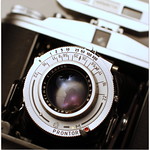
|
| fast Solinar lens image by Fernando Soares (Image rights) |
Unlike the Isolette I and all the preceding models, the film advance knob is on the right. The camera still has a swing-out spool-holder on the supply side of the film chamber.
Under the modified top, there is a double-exposure prevention interlock; this engages after releasing the shutter, and is disengaged by advancing the film. It has a red (locked) or silver (unlocked) indicator in a hole in the top-plate, next to the advance knob. Like the 'T' lock, this interlock acts on the body release button, so if the lock engages accidentally, or a double exposure is desired, it is still possible to release the shutter by pressing the linkage on the shutter itself (or with a cable release, on versions of the camera on which the cable attaches directly to the shutter, not the body release; they vary in this respect).
Like the Isolette I, early versions of the II have a disc-type depth-of-field indicator on the left of the top plate.[6] On later cameras this is replaced with a film-type reminder, and the DOF scale, if any, is on the shutter face-plate.
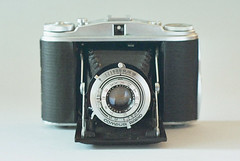
|
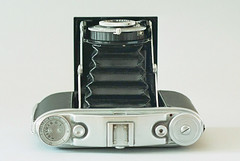
|
 |
| Isolette II with Compur-Rapid shutter (1 - 1/500 second plus 'B') |
Top plate, showing disc-type DOF scale and double-exposure indicator. |
The lever to the right of the viewfinder switches 'B' shutter to 'T'. |
| Images by Dries van den Elzen (Image rights) | ||
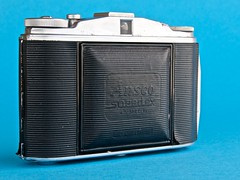
| ||
| The Isolette II was sold as Ansco's Speedex 4.5 Special in the USA. | ||
| Image by Dirk HR Spennemann (Image rights) | ||
Isolette III
| ||
|
The Isolette III (1951-60) is the best-specified Isolette, with an uncoupled rangefinder. The rangefinder is operated with a small knurled thumb-wheel on the right hand of the raised part of the top housing, and the distance is read off and transferred to the lens, which has front-element focusing like all the Isolettes. The lens is either an 85 mm f/4.5 Apotar, with a Pronto or Prontor SV or SVS shutter (all of these are synchronised), or a Solinar, which can be either an 85 mm f/4.5 with a Synchro-Compur shutter in earlier cameras, or a 75 mm f/3.5 with a Prontor SVS, or Synchro-Compur (MX or MXV) in later ones. Some of these f/3.5 Solinar lenses take 32 mm accessories, not the 30 mm ones that fit other Isolettes.
Later cameras also have a film reminder on the left side of the top housing, where the older model has a depth of field indicator.
Examples: One from 1952 (Mark I):
- Objective: Agfa Solinar 1:4.5/85
- Shutter: Deckel Synchro-Compur type MX/CR00-126
One from 1954 (Mark I):
- Objective: Agfa Apotar 1:4.5/85
- Shutter: Pronto
Late model production run (Mark II) -Type 1351:
- Objective: Agfa Solinar 1:3.5/75
- Shutter: Prontor-SVS
It was sold in the USA as Ansco Speedex Special R
|
Isolette L
|
The Isolette L (1957-1960) is a viewfinder camera. It has an uncoupled match-needle selenium lightmeter mounted in the top housing. The lens is a coated 85 mm f/4.5 Color-Apotar, suggesting that the provision of a lightmeter was intended to cater for users of colour film, especially transparencies, concerned to achieve the more exact exposure this might demand. The shutter is a synchronised Pronto, giving speeds 1/25 - 1/200 second, plus 'B'.
The camera has some of the features of the Isolette II and III; the film advance knob is on the right, and has a double-exposure prevention interlock, with a red indicator spot in a tiny window. There is a film-type reminder on the other end of the top housing. Like other models, the camera has a swing-out spool holder on the left (supply) side of the film chamber. The button to unfold the camera is a smaller button on the left end of the top housing; presumably to make space for the meter in the top housing.
Like the original Isolette, the L has hinged blinds mounted on the film roller spindles, allowing it to be used for two different formats. However, the second format of the L is a very unusual 3×6 cm (strictly, a little smaller: 1×2¼ inch). The viewfinder can also be masked for this format, with a small lever beside the cold shoe. Perhaps it was intended that users might cut their films down and mount them as 24×36 mm slides; but the full panoramic format would be attractive to some .
The camera has a red window for normal 12-on-120 frame numbers; advancing the film accurately for the half-frame format might be difficult.[7][8]
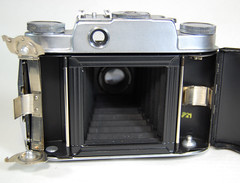 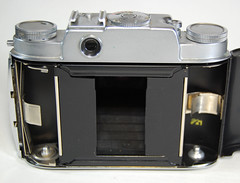
|
| Isolette L film chamber with blinds folded out for 6×6 and in for 3×6 format. images by Hans Kerensky (Image rights) |
Related models
Agfa also made a coupled rangefinder camera, the Super Isolette, which is clearly based on the Isolette series, and produced at the same time as the Isolette I, II and III. This in turn is the basis of the Automatic 66, which has a coupled rangefinder and a light meter coupled to give aperture-priority AE.
Repair Notes
- The weak points of the Isolettes are the grease in the focus helicoid and the bellows:
- Bellows tend to have many pinholes in the corners, especially in the post-war examples made of "shiny" material. Fortunately, replacements are still to be found and replacement is not difficult
Please note if your camera has screws or rivets holding the film transport frame. Rivets found in the pre-war Jsolette and post war Isolette 4.5 make the replacement harder. - Grease of the focusing helicoid can become very hard and must be cleaned using a combination of heat and penetrant oils
Be careful not to break the glass elements when applying force to unscrew the front and rear elements - Grease is also a problem in the Isolete III's rangefinder. It hardens in the focusing dial and in the pivot of the RF mirror, both need to cleaned and relubed.
- Bellows tend to have many pinholes in the corners, especially in the post-war examples made of "shiny" material. Fortunately, replacements are still to be found and replacement is not difficult
Notes
- ↑ 1.0 1.1 1.2 McKeown, James M. and Joan C. McKeown's Price Guide to Antique and Classic Cameras, 12th Edition, 2005-2006. USA, Centennial Photo Service, 2004. ISBN 0-931838-40-1 (hardcover). ISBN 0-931838-41-X (softcover). p25.
- ↑ The name is written as Jsolette simply because the capital "I" resembles a "J" in German typography of the time. The embossing on the camera was changed to a modern "I" in 1937. See: Old German Letters (archived)
- ↑ In fact, Trolitan Presswerk made products in many types of thermoplastic and thermoset resins (and still does; see the company website, retrieved July 2020). The company held patents for several moulded polymer products in the 1950s and 60s: see a list at Espacenet. The Isolette top housing is of a bakelite-like material.
- ↑ 4.0 4.1 User's manual for the Isolette V at Richard Urmonas' homepage. The last page is a correction slip regarding the specifications of the two shutters, and the position of the accessory shoe, which had moved since the manual was produced. Interestingly, the slip gives the company as Agfa Camera Werk, München, US Administration; the Bundesrepublik (West Germany) had only just been formed.
- ↑ 5.0 5.1 User's manual for the Isolette II at Richard Urmonas' homepage.
- ↑ Depth of field indicator on an Isolette II, at Roland and Caroline.
- ↑ Andrew Yue, in his notes on the Isolette L at his site at the University of Texas suggests that one can use the first warning dot between frame numbers, but warns that different makers' films have different markings.
- ↑ Hans Kerensky, in the caption to his picture of the Isolette L (shown above), speculates that Agfa may have marked some of their own film with frame numbers (or with other appropriate marks) for this format.
Links
- Isolette article at German Wikipedia
- Isorette at Ken Lyndrup's website (archived)
- Agfa Isolette II at Matt's Cameras
- Isolettes at Roland and Caroline:
- Agfa Isolette II on www.collection-appareils.fr by Sylvain Halgand (in French)
- Agfa Isolette II Camera Manual : Photo-Manuals.com
- Agfa Isolette II pictures at MFlenses.com
- Agfa Isolette III at Sylvain Halgand's www.collection-appareils.fr (in French)
- Isolette III at Andrew Yue's site
- Camera Rebuilds and Repairs: Agfa Isolette (archived), by David Richert
- Agfa Isolette 4.5 PDF manual from www.OrphanCameras.com
- Agfa Isolette II PDF manual from www.OrphanCameras.com
- Agfa Isolette III PDF manual from www.OrphanCameras.com



